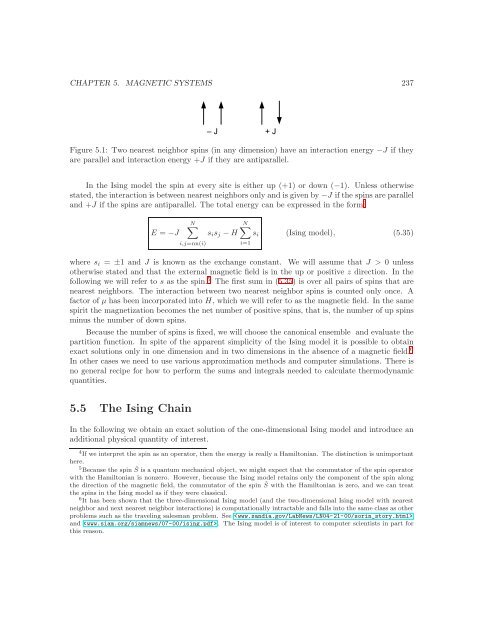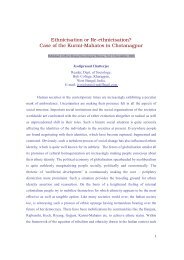Chapter 5 - WebRing
Chapter 5 - WebRing
Chapter 5 - WebRing
Create successful ePaper yourself
Turn your PDF publications into a flip-book with our unique Google optimized e-Paper software.
CHAPTER 5. MAGNETIC SYSTEMS 237<br />
– J + J<br />
Figure 5.1: Two nearest neighbor spins (in any dimension) have an interaction energy −J if they<br />
are parallel and interaction energy +J if they are antiparallel.<br />
In the Ising model the spin at every site is either up (+1) or down (−1). Unless otherwise<br />
stated, the interaction is between nearest neighbors only and is given by −J if the spins are parallel<br />
and +J if the spins are antiparallel. The total energy can be expressed in the form 4<br />
E = −J<br />
N<br />
i,j=nn(i)<br />
sisj −H<br />
N<br />
si (Ising model), (5.35)<br />
i=1<br />
where si = ±1 and J is known as the exchange constant. We will assume that J > 0 unless<br />
otherwise stated and that the external magnetic field is in the up or positive z direction. In the<br />
following we will refer to s as the spin. 5 The first sum in (5.35) is over all pairs of spins that are<br />
nearest neighbors. The interaction between two nearest neighbor spins is counted only once. A<br />
factor of µ has been incorporated into H, which we will refer to as the magnetic field. In the same<br />
spirit the magnetization becomes the net number of positive spins, that is, the number of up spins<br />
minus the number of down spins.<br />
Because the number of spins is fixed, we will choose the canonical ensemble and evaluate the<br />
partition function. In spite of the apparent simplicity of the Ising model it is possible to obtain<br />
exact solutions only in one dimension and in two dimensions in the absence of a magnetic field. 6<br />
In other cases we need to use various approximation methods and computer simulations. There is<br />
no general recipe for how to perform the sums and integrals needed to calculate thermodynamic<br />
quantities.<br />
5.5 The Ising Chain<br />
In the following we obtain an exact solution of the one-dimensional Ising model and introduce an<br />
additional physical quantity of interest.<br />
4If we interpret the spin as an operator, then the energy is really a Hamiltonian. The distinction is unimportant<br />
here.<br />
5Because the spin Sˆ is a quantum mechanical object, we might expect that the commutator of the spin operator<br />
with the Hamiltonian is nonzero. However, because the Ising model retains only the component of the spin along<br />
the direction of the magnetic field, the commutator of the spin ˆ S with the Hamiltonian is zero, and we can treat<br />
the spins in the Ising model as if they were classical.<br />
6It has been shown that the three-dimensional Ising model (and the two-dimensional Ising model with nearest<br />
neighbor and next nearest neighbor interactions) is computationally intractable and falls into the same class as other<br />
problems such as the traveling salesman problem. See <br />
and . The Ising model is of interest to computer scientists in part for<br />
this reason.

















